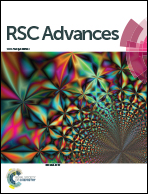Supercritical synthesis of a magnetite-reduced graphene oxide hybrid with enhanced adsorption properties toward cobalt & strontium ions†
Abstract
The current study presents a supercritical synthesis of magnetite-reduced graphene oxide (M-RGO) in methanol media, in which Fe3O4 nanoparticles are simultaneously formed, surface modified and decorated on the surface of the reduced graphene oxide. Simulations using density functional theory, which were performed using the M06-2x/cc-pVDZ level of theory, indicate that upon adsorption of a Fe3O4 cluster on the graphene, the overall charge on the graphene surface becomes about −0.0236e, indicating charge transfer from the Fe3O4 cluster to the graphene surface. Instrumental and chemical analyses exhibited the formation of strong bonds between Fe3O4 and graphene, through C–O–Fe and C–Fe bridges. Based on this data the study puts forward a formation mechanism for M-RGO. The adsorption behavior of the M-RGO towards Co2+ and Sr2+ ions demonstrated an appreciably higher uptake capacity than that of magnetite-graphene oxide (M-GO), a zero zeta potential point at pH ≈ 2, endothermic and spontaneous adsorption, and fast kinetics that was controlled by the chemical reaction between the ions and the surface active sites of the Fe3O4 nanoparticles. The material also showed good reusability, quick elution by 0.5 mol dm−3 HCl, and most importantly, simple separation from the solution using a magnet. Overall, the M-RGO appears to be a promising alternative for the current magnetite-graphene oxide hybrids in the adsorption of heavy metal ions.


 Please wait while we load your content...
Please wait while we load your content...